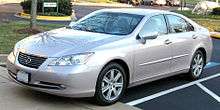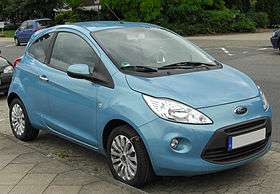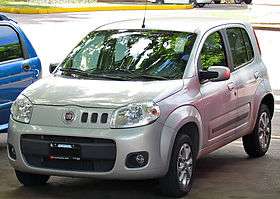Car platform
A car platform is a shared set of common design, engineering, and production efforts, as well as major components over a number of outwardly distinct models and even types of cars, often from different, but related marques.[2] It is practiced in the automotive industry to reduce the costs associated with the development of products by basing those products on a smaller number of platforms. This further allows companies to create distinct models from a design perspective on similar underpinnings.[2]
Definition and benefits
Platform sharing is a product development method where different products and the brand attached share the same components.[3] The purpose with platform sharing is to reduce the cost and have a more efficient product development process.[4] The companies gain on reduced procurement cost by taking advantage of the commonality of the components. However, this also limits their ability to differentiate the products and imposes a risk of losing the tangible uniqueness of the product. The companies have to make a trade-off between reducing their development costs and the degree of differentiation of the products.[3]
One of the first car companies to use this product development approach was General Motors in 1908.
A basic definition of a platform in cars, from a technical point of view, includes: underbody and suspensions (with axles) — where the underbody is made of front floor, underfloor, engine compartment and frame (reinforcement of underbody).[5] Key mechanical components that define an automobile platform include:
- The floorpan, which serves as a foundation for the chassis and other structural and mechanical components
- Front and rear axles and the distance between them - wheelbase
- Steering mechanism and type of power steering
- Type of front and rear suspensions
- Placement and choice of engine and other powertrain components
| Examples of cars sharing the Fiat Mini platform | ||||||||||
|---|---|---|---|---|---|---|---|---|---|---|
|
Vehicle platform-sharing combined with advanced and flexible-manufacturing technology enables automakers to sharply reduce product development and changeover times, while modular design and assembly allow building a greater variety of vehicles from one basic set of engineered components.[6] Many vendors refer to this as product or vehicle architecture. The concept of product architecture is the scheme by which the function of a product is allocated to physical components.[7]
The use of a platform strategy provides several benefits:[5]
- Greater flexibility between plants (the possibility of transferring production from one plant to another due to standardization),
- Cost reduction achieved through using resources on a global scale,
- Increased use of plants (higher productivity due to the reduction in the number of differences), and
- Reduction of the number of platforms as a result of their localization on a worldwide basis.
The car platform strategy has become important in new product development and in the innovation process.[8] The finished products have to be responsive to market needs and to demonstrate distinctiveness while — at the same time — they must be developed and produced at low cost.[5] Adopting such a strategy affects the development process and also has an important impact on an automaker's organizational structure.[5] A platform strategy also offers advantages for the globalization process of automobile firms.[9]
Because the majority of time and money by an automaker is spent on the development of platforms, platform sharing affords manufacturers the ability to cut costs on research and development by spreading the cost of the R&D over several product lines. Manufacturers are then able to offer products at a lower cost to consumers. Additionally, economies of scale are increased, as is return on investment.[2][10]
Examples
Originally, a "platform" was a literally shared chassis from a previously-engineered vehicle, as in the case for the Citroën 2CV platform chassis used by the Citroën Ami and Citroën Dyane, and Volkswagen Beetle frame under the Volkswagen Karmann Ghia. Platform sharing has been a common practice since the 1960s when GM used the same platform in the development of the Pontiac LeMans, the Buick Skylark, the Chevrolet Chevelle, and the Oldsmobile Cutlass.
In the 1980s, Chrysler's K-cars all wore a badge with the letter "K" to indicate their shared platform. In later stages, the "K" platform was extended in wheelbase, as well as use for several of the Corporation's different models.
GM used similar strategies with its "J" platform that debuted in mid-1981 in four of GM's divisions. Subsequent to that, GM introduced its "A" bodies for the same four divisions using the same tread width/wheelbase of the "X" body platform, but with larger body work to make the cars seem larger, and with larger trunk compartments. They were popular through the 1980s, primarily. Even Cadillac started offering a "J" body model called the Cimarron, a much gussied up version of the other four brands' platform siblings. A similar strategy applied to what is known as the N-J-L platform, arguably the most prolific of GM's efforts on one platform. Once more, GM's four lower level divisions all offered various models on this platform throughout the 1980s and into the 1990s.
 1986 Opel Ascona C |
 1988 Pontiac Sunbird |
 1988 Cadillac Cimarron |
Japanese carmakers have followed the platform sharing practice with Honda's Acura line, Nissan's Infiniti brand, and Toyota's Lexus marque, as the entry-level luxury models are based on their mainstream lineup. For example, the Lexus ES is essentially an upgraded and rebadged Toyota Camry.[11][12][13][14] After Daimler-Benz purchased Chrysler, Chrysler engineers used several M-B platforms for new models including the Crossfire which was based on the M-B SLK roadster.[15] Other models that share platforms are the European Ford Focus, Mazda 3 and the Volvo S40.[16]
Differences between shared models typically involve styling, including headlights, tail lights, and front and rear fascias. Examples also involve differing engines and drivetrains. In some cases such as the Lexus ES that is a Toyota Camry, "same car, same blueprints, same skeleton off the same assembly line in the same factory", but the Lexus is marketed with premium coffee in the dealership's showroom and reduced greens fees at Pebble Beach Golf Links as part of the higher-priced badge.[17]
Platform sharing may be less noticeable now; however, it is still very apparent. Vehicle architectures primarily consist of "under the skin" components, and shared platforms can show up in unusual places, like the Nissan FM platform-mates Nissan 350Z sports car and Infiniti FX SUV. Volkswagen A platform-mates like the Audi TT and Volkswagen Golf also share much of their mechanical components but seem visually entirely different. Volkswagen Group and Toyota have both had much success building many well differentiated vehicles from many marques, from the same platforms. One of the least conspicuous recent examples is the Chevy Trailblazer and Chevy SSR; both use the GMT-360 platform.
Advantages
- Easier inventory management/smaller number of parts
- Platform sharing allows for fewer parts for different models of vehicles and therefore the task of inventorying those parts is greatly reduced.[2]
- Lower development costs
- Platform sharing allows manufacturers to cover many different market segments when a platform sharing strategy is implemented. This is exemplified by Ford Motor Co. in the case of the Ford Explorer, Mercury Mountaineer and Lincoln Aviator. They are essentially the same only they are considered mass-market, near luxury and luxury vehicles.[10]
- Increased quality and innovation
- Platform sharing allows manufacturers to design parts with fewer variation. A byproduct of this is increased quality, which results in lower defect rates.[2]
- Global standardization
- Platform sharing allows manufacturers to design flexible platforms that can be tailored to a country's specific needs without compromising quality. It also allows for manufacturing standardization and improved logistics.[2]
- Greater product variety
- Platform sharing allows manufacturers to build/design differentiated products faster and cheaper. This is possible because the development and cost of the original platform have already been paid for.[2]
Disadvantages
- Badge engineering
- Manufacturers that practice platform sharing have the ability to create several models based on the same design, but with different names. This leads to the public looking over certain models and cannibalized sales from competing divisions with essentially the same product. This was prevalent among U.S. domestic manufactures from the 1970s onward, e.g., the Chevrolet Trailblazer, GMC Envoy, Buick Rainier, Saab 9-7X, and Isuzu Ascender.[2][15][18]
- Incompatible changes to platforms
- The two elements of platforms are constant and non-constant. If the non-constant elements are not designed to be easily integrated into the constant elements of the platform, extensive and expensive changes will have to be made in order to make the elements compatible again. Failure to do so negates the purpose of platform sharing in that it increases costs as opposed to reducing them.[2][10]
- Product dilution
- Platform sharing has the ability to be used in too many different models. However, in the mind of the consumers, the products may be too similar and more expensive products may be perceived to be cheaper.[2] For example, the perceived value of a "luxury" brand may be not as desirable if it is too similar to a mass-market version of the same platform. Conversely, platform sharing may increase the price of the economic models.[2] Examples of luxury vehicles that suffered from being based on economy platforms include the Cadillac Cimarron, the Chrysler TC by Maserati, the Maybach 57 and 62 and the Jaguar X-Type.
- Risk concentration/higher recall rate
- The propensity for a higher number of recall is greatly increased with platform sharing. If a defect is found in one model and that model shares its platform with ten other models, the recall would be magnified by ten thus costing the manufacturer more time and money to fix.[2][10] An example of problems spreading across platforms and numerous versions of models are the 2009–11 Toyota vehicle recalls.
See also
- List of Chrysler platforms
- List of Fiat platforms
- List of Ford platforms
- List of GM platforms
- List of Hyundai-Kia platforms
- List of Mazda platforms
- List of Mitsubishi platforms
- List of Nissan platforms
- List of Toyota platforms
- List of Volkswagen Group platforms
References
- ↑ Edmonston, Phil (2003). Lemon-Aid Used Cars and Minivans 2004. Penguin Group. p. 294. ISBN 978-0-670-04375-0. Retrieved 6 November 2010.
Used luxury cars can be great buys, if you ignore all the hype, know how to separate symbol from substance, and are smart enough to know that most of the high-end models don't give you much more than their lower-priced entry-level versions. For example, the Lexus ES 300 is a Toyota Camry with a higher price.
- 1 2 3 4 5 6 7 8 9 10 11 12 Brylawski, Michael (27–29 September 1999). "Uncommon Knowledge: Automobile Platform Sharing's Potential Impact on Advanced Technologies, pre-print for the 1st International Society for the Advancement of Material and Process Engineering (SAMPE) Automotive Conference". International Society for the Advancement of Material and Process Engineering. Archived from the original on 28 November 2010. Retrieved 6 November 2010
- 1 2 Olson, Erik L (2008). "Implication of platformsharing on brand value". Journal of product and brand management. 17.
- ↑ Robertson, David; Ulrich Karl (1998). "Planning for product platforms". Sloan management. 39.
- 1 2 3 4 Muffatto, Moreno (20 April 1999). "Introducing a platform strategy in product development". International Journal of Production Economics. 60-61: 145–153. doi:10.1016/S0925-5273(98)00173-X
- ↑ Schlie, Erik; Yip, George (August 2000). "Regional follows global: strategy mixes in the world automotive industry". European Management Journal. 18 (4): 343–354. doi:10.1016/S0263-2373(00)00019-0
- ↑ Ulrich, Karl (1995). "The role of product architecture in the manufacturing firm". Research Policy. 24 (3): 419–441. doi:10.1016/0048-7333(94)00775-3
- ↑ Muffatto, Moreno (1999). "Platform strategies in international new product development". International Journal of Operations & Production Management. 19 (5/6): 449–460. doi:10.1108/01443579910260766. Retrieved 6 November 2010
- ↑ Wilhelm, B. (1997). "Platform and modular concept at Volkswagen – their effect on the assembly process". In K. Shimokawa, U. Jürgens, and T. Fujimoto. Transforming Auto Assembly. Springer. pp. 146–156.
- 1 2 3 4 Balu, Deepak (30 June 2004). "Automotive Platform Sharing: an Overview". Frost & Sullivan. Retrieved 6 November 2010.
- ↑ Kiplinger Washington Editors, Inc (June 1992). "Rebate time and the cars are cheaper". Kiplinger's Personal Finance. 46 (6): 98. Retrieved 6 November 2010.
The most upscale Toyota Camry, the V6 XLE, and the entry-level Lexus ES 300 are clones, but the price difference between them is over $4500. For that you get a more finely finished interior on the Lexus and the promise of better service...
- ↑ Simmons, Lee; Simmons, Barbara (1997). Penny pinching. Bantam Books. p. 131. ISBN 978-0-553-57366-4.
Toyota Camry XLE V-6 has exactly the same engine and shares many of the same body specifications with the Lexus ES 300. Comparably equipped, except for minor items
- ↑ Edmonston, Phil (2004). Lemon Aide Guide 2005: New Cars and Minivans. Penguin Group. p. 145. ISBN 978-0-14-301637-3.
- ↑ Perloff, Jeffrey M. (2004). Microeconomics. Pearson Addison Wesley. p. 672. ISBN 978-0-321-16073-7. Retrieved 6 November 2010.
... are automotive twins, as are the Toyota Camry and Lexus ES 300.
- 1 2 Csere, Csaba (June 2003). "Platform Sharing for Dummies". Car and Driver. Retrieved 6 November 2010.
- ↑ "Q&A: Richard Parry-Jones, Ford Global Product Development VP". Automobile Magazine. April 2009. Retrieved 6 November 2010.
- ↑ McFarlane, Greg; Kincaid, Betty (2010). Control Your Cash: Making Money Make Sense. Mill City Press. p. 142. ISBN 978-1-936107-88-9. Retrieved 6 November 2010.
Take the Lexus ES. It boasts the sexy panache of style and elegance that no other sedan can compare to. Except the quotidian Toyota Camry, that is. Same car. Same blueprints, same skeleton off the same assembly line in the same factory, ...
- ↑ "Inside Truck Platform Sharing". Motor Trend. 2008-04-22. Archived from the original on 20 April 2008. Retrieved 2008-04-29.






